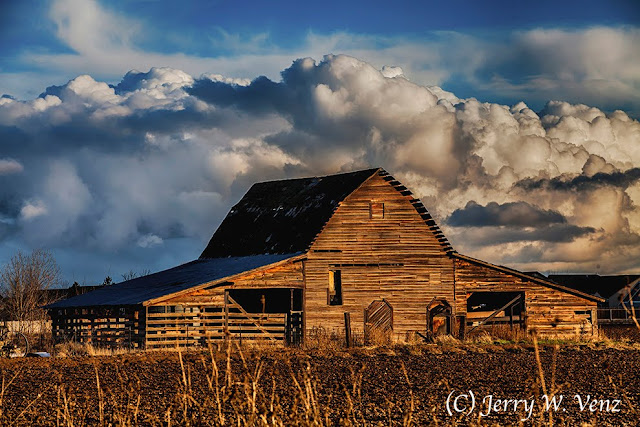I think that within 10 years most, if not all, of the barns here in the treasure Valley (Idaho) will be gone. It’s no wonder with the development boom in Boise, Meridian, Eagle, Star and Nampa that has accelerated since 2015. I’m glad I started my documentation of these old structures in 2010, since we’ve been loosing 2 or 3 barns a year in our area.
So, the barns I’ve been documenting have been those with encroaching housing subdivisions nearby. I know the barn’s days are numbered when they stop planting any crops on the property. Then they often tear down the farm house and put up the for sale sign and I know the clock is ticking. The reason I watch for all of these “signs” is that I’m not merely “documenting” these barns—my goal has been to create barn photography as art. It takes time to artistically capture any of the outdoor structures (manmade or natural) that I focus on.
Here are my criteria for how and when I will bring my camera to bear on an outdoor subject:
- Which Direction is the Best “side” of the subject facing relative to the sun? In other words what is the barn’s best side and when is the sun going to be in the position to give it directional lighting. That is lighting that will create shadows and bring out the details in the barn’s wood—I avoid flat lighting in most cases.
- With my subject’s directional face known then I know if my barn is going to be a sunrise or sunset subject. Then I have to see what time to start photography. Just knowing these first two criteria may take several visits to the site.
- Next I decide if I want to include the crop (if they’re still planting) in the foreground for the overall portrait of the barn. Depending on the crop it may obscure this view of the barn.
- Finally, if it’s a large barn I’ll probably want nice clouds since with a large view there’s always a lot of sky.
This barn illustrates my criteria….
 |
|
f10.0 @ 1/400 sec., ISO 400; lens @ 160mm
|
- This barn’s best side is facing West; look at all that great detail!
- So, I needed to use the setting sun that still gave me the shadows at the “A” frame of the barn’s roof; this worked out to be about 5pm in December.
- They had been planting corn in this field and that meant this view of the barn would not be possible with a crop of corn seven feet high.
- The Big issue for me was getting a nice big cloud structure behind that big barn.
It took two years for all these criteria to coincide for this barn’s portrait. Why so long you ask? Well, I’m a full time professional photographer and my paying clients come first. That means that my outdoor family portrait sessions usually happen one or two hours before sunset—and that’s also prime barn photography time.
Back to this barn….
 |
|
f10.0 @ 1/400 sec., ISO 400; lens @ 150mm
|
After I get the overall view I start slicing-up the barn into detail images. I love the shadows here that create the three-dimensionality necessary to create textures and the drama that we as artists should seek.
Flash forward almost two years….
 |
|
f16.0 @ 1/250th sec., ISO 400/ Lens @ 75mm
|
This barn is still standing and I finally decided I wanted a corn crop in the foreground! Of course, they had planted other types of crops in the intervening years—so, I had to wait for the corn crop (again!). Drat those Idaho farmers and their pesky crop rotations—guess they know what they’re doing!
This is the image I had pre-visualized.…
 |
|
f16.0 @ 1/250 sec., ISO 400; Lens @ 123mm
|
Love the corn reaching for the barn…and that great shadowed texture on the face of the barn, with nice clouds behind it. And lastly a B&W conversion to make the scene really dramatic. I used one of my favorite B&W conversion plug-ins—NIK, Silver, Efex Pro 2 using the fine art process preset (with my changes to taste) and an overlay of one of NIK’s film types. In this case I used their T-Max 100 film emulation
Next week I’ll continue with this topic showcasing other barns in my quest to create art and preserve some history.
Always open for questions….’Til next week…
Author: Jerry W. Venz, PPA Master Photographer, Craftsman
Training site: http://www.LightAtTheEdge.com
Client site: http://www.TheStorytellersUsa.com










